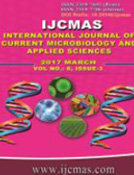


 National Academy of Agricultural Sciences (NAAS)
National Academy of Agricultural Sciences (NAAS)

|
PRINT ISSN : 2319-7692
Online ISSN : 2319-7706 Issues : 12 per year Publisher : Excellent Publishers Email : editorijcmas@gmail.com / submit@ijcmas.com Editor-in-chief: Dr.M.Prakash Index Copernicus ICV 2018: 95.39 NAAS RATING 2020: 5.38 |
To determine the prevalence of intestinal parasites among school children belonged to different communities from urban, peri-urban and rural areas in Khurda district, Odisha, India. Stool samples were collected from the school children according to the standard procedures. All the stool samples were examined by the direct microscopic examination and by the formalin - ether concentration methods. A total of 1114 stool specimen were collected from different schools in 1995. The total prevalence rate of parasitic infection was 50.5%; 24.5% had single protozoan infection, 14.7 had single helminthic infection and 11.2% had mix infection. It was observed that Ascaris lumbricoids was the predominant helminthic infection (8.6%) and Entamoeba histolytica was the predominant protozoan infection (11.7%) in school children from semi-urban area in the vicinity of Bhubaneswar city, which revealed a higher rate (68.3%) of parasitic infections than rural Odisha school children (40.3%) and urban (40.6%) school children from the city of Bhubaneswar. School children from Hindu communities were found to be infected more with protozoan infections (26.6%) while; Muslim children were infected more with helminthic infection (54.4%). The Semi-urban school children possess high parasitic infections than rural Odisha school children. However, there was no significant difference in the rate of parasitic infections between the two sexes in any given group.
 |
 |
 |
 |
 |